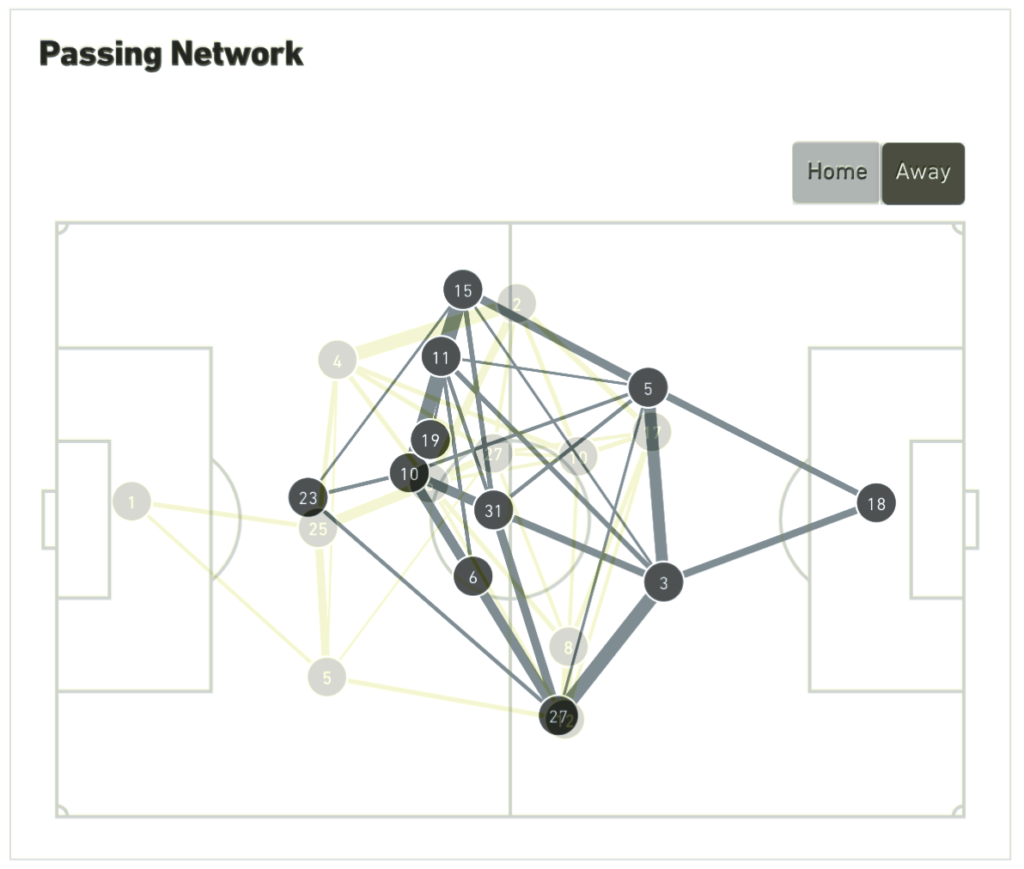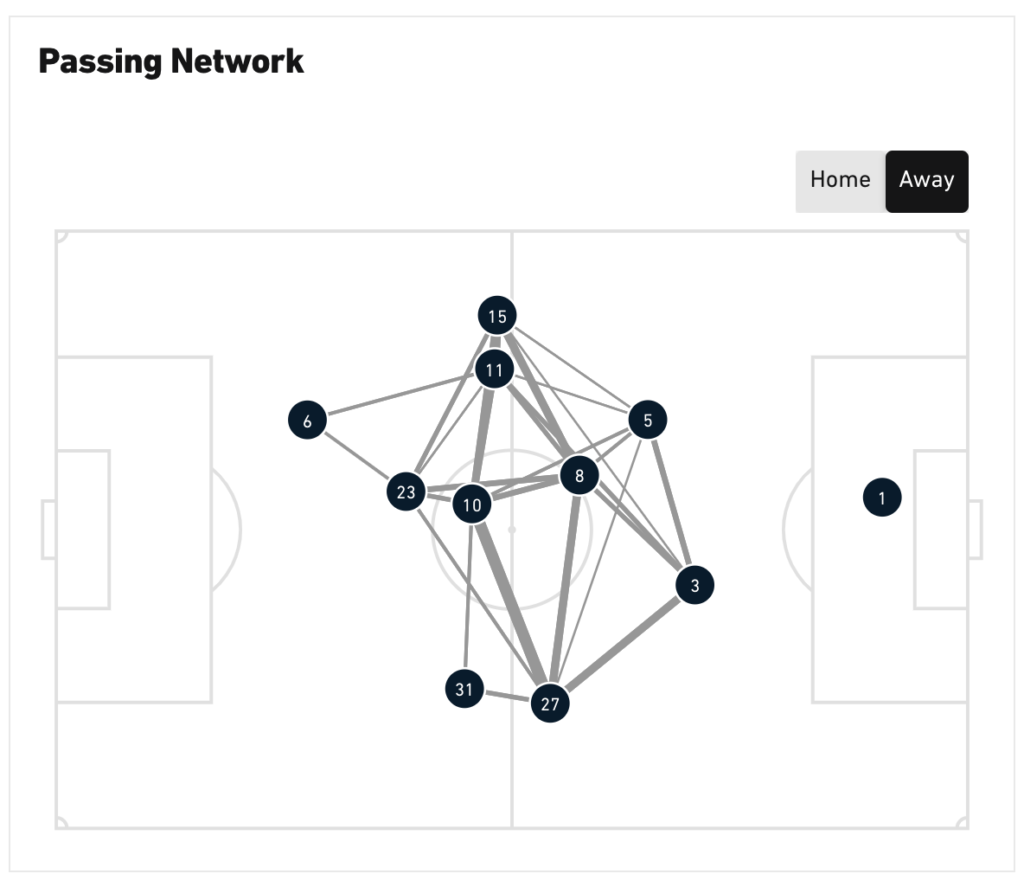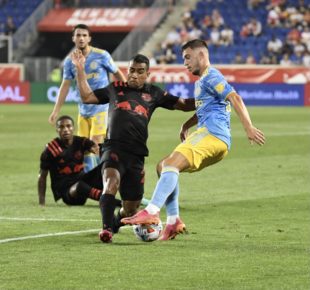Photo by Marjorie Elzy
A lack-luster road trip for the Union included a disappointing result in Nashville and an inspired if ultimately unsatisfactory one in Harrison.
There is a positional problem that comes out of the Music City and a question of growing chemistry that comes out of the Meadowland swamps – both things the Union will need to address as their season winds on toward the Azteca.
Nashville, TN
Between New York City FC, Chicago Fire, and now Nashville SC, the Union are finding out that other teams have a tool in their kit to neutralize the Boys in Blue’s diamond press: odd numbers in the midfield.
Nashville is known for being defensively stout and disruptively physical. Their formation against the Union was a 3-5-2, which allowed both overarching characteristics to specifically address the weakness of the Union’s 4-4-2: the formation’s lack of width, and the otherworldly responsibilities placed on Olivier Mbaizo and Kai Wagner to address it.
Both wide players are required to maraud and attack with relentless guile, while also being positionally sound and stalwart defenders. They’re the only players consistently on the outside of the formation after all.
When an opponent adds a 5th player to their midfield, two things happen.
- Opponents can pin the Union’s wingbacks into deep positions without sacrificing their own team’s defensive responsibilities. They can do this because the wingers know they have three defenders behind them and another three midfielders to help out, an equal six players to the six the Union have in their midfield and attacking ranks – it’s almost like reward without risk, playing a lottery with only one buyer and one winner.
- Since the Union’s wingbacks are pinned deep because of their defensive responsibilities, all of their required offensive contributions become more significantly secondary. If no one can slide up and down the wing, pulling opponents out of shape and making passing triangles with an otherwise narrow midfield, it becomes difficult to generate offense.
This conundrum will find the Union during games in which the score is tied or those in which they have the lead. Unfortunately, in each of the three aforementioned contests, the Union were either down a goal in the first two minutes or down a man in the first fifteen. These mountains made the Union’s climb different, but with the same effect.
In Nashville, the Union pushed high, taking the space afforded them after an early and unexpected goal and the host’s subsequently bunkered bus. By overlaying the Union’s positional chart (in gray) atop Nashville’s (in yellow-ish), it’s clear that the right-leaning Union could only get Olivier Mbaizo so far up the pitch while Kai Wagner was simply stuck – his position is almost exactly the same as that of Nashville’s right midfielder Alistair Johnston.
That flat line of Union players across the midfield, linked together by thick gray lines? That’s what it looks like the ball gets to midfield with nowhere to go.

Courtesy of Major League Soccer
Harrison, NJ
Daniel Gazdag finally got his attacking start against the Mighty Metros. Instead of lining up as a midfielder though (Union fans want him at the tip of the diamond he says he belongs more naturally on the side of it), he found himself next to Kacper Pryzbylko atop the team’s formation.
Pryzbylko is eager to link play when the Union have the ball, constantly checking toward possessing midfielders and fullbacks alike. This is good news for his teammates in keeping the ball, but not always great news for what happens when they get to the final third: Pryzyblko isn’t always in the mix for the resulting cross in from the wing because, well, he’s on the wing.
When it works, like it did in the season opener against Saprissa, his checking to the ball opens space for others to run in behind him and opens space for him to run in behind the play as he catches up. When it doesn’t, it leaves his teammates having to recycle opportunities in otherwise decent spaces.
The addition of Gazdag had Union fans expecting Kacper to rid himself of those responsibilities. Gazdag is more technically gifted and him checking instead of the Striker Muffin would free the target man to be just that, a target man. Old habits die hard though, and while Gazdag was leading the line in shots on goal and xG against the Bulls, Pryzybylko was linking passes with Monteiro and Mbaizo and finishing the night without a single scoring chance.

Courtesy of Major League Soccer
The Union are going to spend the summer figuring out the right pairings in their midfield and striker partnerships. For a first foray with these two players up top, against a team that doesn’t allow much in the way of chemistry-building because of their high press, the results weren’t bad but they also weren’t good enough. The next time out, the team need to allow Pryzbylko to be the target man he’s capable of being, while allowing Gazdag to be the triangle- and quadrilateral-maker his skill set calls for.
That will make those otherwise aimless crosses into the box become quite a bit more dangerous, and allow Gazdag, Montiero, and the midfield to offer attacking options that don’t require swinging the ball in.


I’m not terribly tactically astute, but the 4-4-2 diamond seems to leave this team with an unfocused and lopsided attack. Anything that keeps Przbylko deep or too wide doesn’t seem right. People seem to think Gazdag will help sort this out, but for the 4-4-2 to work, he needs to be a playmaker. I’m not sure he fits that bill.
–
I know the system is now king, but I wonder how the Union would look in a straightforward 4-3-3 — same backline, Martinez at the 6, Montiero and Bedoya as the AMs in front of him, Santos at LF, Przbylko CF and Gazdag RF. Keep Przbylko prowling around and in front of the box.
–
It’s all academic, I guess. Any team in attack is eventually going to take some sort of 2-3 or 3-2-5 shape in attack to be successful. And a 4-4-2 diamond looks a lot like a 4-3-3 in many ways. I just think that perhaps there’s a tactical change that would better usethr players we have.
I think you’re right on both counts: it’s not working exactly right yet, but that the formation itself may not matter. I suspect the team will look a lot more cohesive in September than they do in July.
There has to be something the 4-4-2 diamond can do that counters the 3-5-2 if executed correctly. (altering the press / passing over vs playing through the midfield ? ) Every formation should be able to counter any other formation given better players and some training. I expect the team has been working on how to break down a low block and how to better handle an overloaded mid-field.
I think the answer is better connections through the midfield. If the opponent wants to isolate two players like that with two of their own, that means everything other portion of the field should be open (especially with 3 in the back, where the Union should then have a 4 v 3 advantage in the remaining midfield). Right now the chemistry isn’t there, going straight is harder than going sideways. As it grows though, it’ll make the above strategy less appealing because the Union will be ready for it.
Ilsinho is reported by Curtin to have played 25 minutes in a scrimmage against Union II.
.
D. C.’s 3-5-2 may get matched up against a 4-2-3-1. It will be a rusty one, but that tactical shift may now become available.